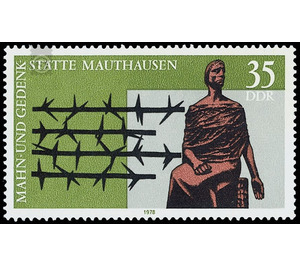Commemorative stamp series - Germany / German Democratic Republic 1978 - 35 Pfennig
Theme: Architecture
| Country | Germany / German Democratic Republic |
| Issue Date | 1978 |
| Face Value | 35.00 |
| Color | green |
| Perforation | K 14 |
| Printing Type | Rotogravure 2 |
| Stamp Type | Postage stamp |
| Item Type | Stamp |
| Chronological Issue Number | 2098 |
| Chronological Chapter | GER-DDR |
| SID | 156112 |
| In 18 Wishlists | |
Mauthausen memorial and memorial As part of the series "international remembrance and memorial sites", the Ministry of Posts and Telecommunications of the German Democratic Republic issues another multi-colored postage stamp. Special cancellations from September 5 to November 4, 1978 The fascist Mauthausen concentration camp As in all European countries invaded and raped by the German fascists, a concentration camp was built in Austria immediately after the invasion of the fascist Wehrmacht in March 1938 To physically annihilate anti-fascists of all political tendencies, communists, social democrats, bourgeois democrats and other opponents of the fascist dictatorship. The Mauthausen concentration camp, near the Upper Austrian market town of the same name, not far from the industrial city of Linz on the Danube, was not only the first concentration camp established by German fascism outside the Reichsgrenze, but also earned its sad reputation as one of the cruelest torture sites of German imperialism to be. From its inception, it was the only camp of the "Tier III", including its 49 subcamps, meaning that those arrested here were considered "incorrigible" and were accompanied by the directive "return unwanted". In practice, this was an additional death sentence and meant extermination through forced labor in the notorious quarry or armaments industry, starvation as a result of systemic malnutrition, and unrestrained physical terror. The life expectancy of a prisoner in the concentration camp Mauthausen was about six months from 1939/40 to summer 1943 on a statistical average and then about five months until the end of the war. In reality, thousands of those entombed in Mauthausen did not survive the first 24 hours as they were either immediately driven into the gas chamber or otherwise cruelly murdered. This concerned in particular Soviet officers and political commissars, but also other categories of prisoners from almost all European countries, which were never counted and whose number can no longer be determined. The "official" number of deaths of 122,000 is nowhere near the number of those actually murdered. The direct beneficiaries of the forced labor of the prisoners were primarily imperialist corporations such as Heinkel AG, Messerschmitt AG, Steyr-Daimler-Puch AG and others who could increase their armaments profits by the most brutal exploitation of the work force of the inmates. The conscious and organized resistance of the prisoners against the inhuman terror and murder regime in the Mauthausen concentration camp began early. Born of mutual solidarity and solidarity, under the leadership of communists, including Germans, a well-established international anti-fascist resistance organization, led by the International Warehouse Committee, grew. The resistance, despite constant danger of antifascist reconnaissance work, the strengthening of the certainty of victory over effective help for fellow prisoners in particularly difficult situations for organized sabotage of armaments production and finally to the procurement of weapons in preparation for a possible armed conflict with the SS in the follies of their attempt, as the Allied armies approach, assassinate all surviving inmates. After the Soviet army had liberated Vienna and could advance to Linz, the area around Mauthausen was one of the places where the last act of fascist defeat took place. On May 4, 1945, the International Mauthausen Committee took over the entire internal administration of the camp. The SS had either been disarmed or fled. On May 5, the Mauthausen concentration camp was liberated under the decisive participation of the military resistance organization of the anti-fascist prisoners. The US Army occupied the territory around Mauthausen, which now belonged to the US occupation zone of Austria, and made the counterterrorist prisoners who wanted to return to their exempted from the Soviet army homeland, still countless difficulties. The former political prisoners from the Mauthausen concentration camp, who had returned to the then Soviet-occupied zone of Germany, immediately took on responsible tasks in the revolutionary transformation of their restored home country. The memorial of the GDR, of which the stamp shows a section, was built by the committee of the anti-fascist resistance fighters of the GDR on the grounds of the former concentration camp Mauthausen and inaugurated on 5 May 1967.


